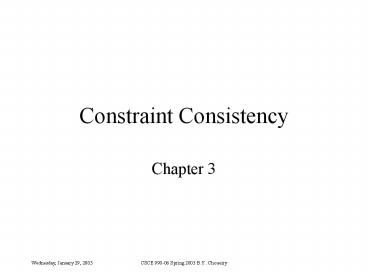Constraint Consistency PowerPoint PPT Presentation
Title: Constraint Consistency
1
Constraint Consistency
- Chapter 3
2
Section 3.3
- Definition 3.3.2 Path Consistency,
- Two variables relative to a third
- non-binary, binary
- Three variables
- A network (note Rij i?j)
- Revise-3 updates binary constraints, not domains
- PC-1, PC-3 (like AC-1, AC-3) update binary
constraints, not domains - This is not the PC-3 algorithm of Mackworth!!
3
Section 3.4
- i-consistency
- A relation is i-consistent (Dy, y not specified
in S!!) - A network is i-consistent (i not specified
distinct ?) - Algorithms Revise-i, i-consistency-1
- Should variables be distinct?
- Note complexity
4
Section 3.4.1
- for binary CSPs,
- Path-consistency ? 3-consistency
- with ternary CSPs, ternary constraints are
accounted for
5
Section 3.5.1
- Generalized arc-consistency
- non-binary CSPs
- checks value support in domain of variables
- updates domains
- complexity
- Relational arc-consistency
- non-binary CSPs
- updates relations RS-x
6
Section 3.5
- No transition between 3.5 and 3.5.1, it would be
good to have one
7
Section 3.5.2
- Global constraints
- non-binary constraints dictated by practical
applications - scope is parametrized
- Relational description is unrealistic, defined
intentionally (error implicit) - Specialized algorithms ensure generalized
arc-consistency - Examples alldifferent, sum, global cardinality
(generalization of alldifferent), cumulative,
cycle
8
Section 3.5.3
- Bounds consistency, large ordered domains, not
necessarily continuous - Bind domains by intervals
- Ensure that interval endpoints are AC
- Weaker notion of consistency, cost effective
- Mechanism tighten endpoints until AC.
- Example alldifferent in O(nlogn)
9
Historical note
- The concepts of global constraint and bound
consistency were developed in the context of
Constraint Programming.
10
Section 3.6
- Constraints with specific semantics (non-random)
e.g., numeric/algebraic, boolean - Implications on
- Arc-consistency
- Path-consistency
- Generalized arc-consistency
- Relational arc-consistency
11
3.6 Algebraic constraints
- Too general term, in fact linear inequalities
- Constraint composition is linear elimination
- Binary case constraints of bounded difference
- Arc-consistency filters domains
- Path-consistency tightens/adds binary constraints
- Non-binary case (non-negative integer domains,
why?) - Generalized arc-consistency filters domains
- Relational arc-consistency tightnes/adds
constraints
12
3.6 Boolean Constraints
- Domain filtering unit clause
- Binary clauses
- Constraint composition is the resolution rule
- Arc-consistency achieved adding unit clause
(unary constraint) - Path consistency achieved adding a binary clause
- Non-binary clauses
- Generalized arc-consistency wont yield new unit
clauses - Relational arc-consistency adds new clauses by
unit resolution tractability of unit propagation
algorithm
13
Section 3.7
- Arc-consistency, path-consistency are sometimes
guaranteed to solve the CSP - Restricted classes
- Topologic restrictions tree-structured
- Arc-consistency guarantees solvability
- Domains restrictions bi-values domains, CNF
theories with clause length 1 or 2 - Path-consistency guarantees solvability
- Constraint semantic Horn Clauses
- Unit propagation/resolution (relational-arc
consistency) guarantees solvability (see
tractability of Horn Theories in CSE 876)
14
Section 3.8
- Notice how non-binary constraints are depicted in
Figures 3.17, 3.18 contours instead of box
nodes. This is inherited from DB literature.

